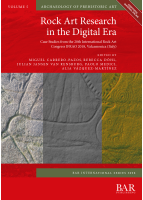Description
Rock Art Research in the Digital Era covers the research presented at the 20th International Rock Art Congress (IFRAO) held in Darfo Boario Terme, Valcamonica (Italy), from 29 August - 2 September 2018. With a broad understanding of digital archaeology, a diverse range of specialists demonstrate how digital technologies can benefit the study of rock art in a variety of contexts. Digital methods and 3D modelling are significantly changing the field of rock art documentation and interpretation, with new approaches that allow us to make eroded rock art panels more visible, especially in cases where the human eye or a raking light is ineffective. Using numerous case studies, this book illustrates how cutting-edge methodologies are integrated within 3D modelling workflows, and how these can manage and disseminate the results to the public in an interactive way.
EDITORS
Miguel Carrero-Pazos is a Lecturer in prehistory at the University of Oviedo. He is a specialist in computationally informed landscape archaeology, and his research focuses on the application of GIS and spatial statistics to model monumental landscapes.
Dr Rebecca Döhl is a Lecturer at the Institute of Archaeology who specialises in rock art research, landscape archaeology, GIS, 3D photogrammetry, and Digital Humanities. Since 2016, she has been the project coordinator for Corpus of Ancient Egyptian Multimodal Communication (Humboldt University of Berlin).
Dr Julian Jansen van Rensburg, who works for the Centre for Middle Eastern Plants, is the world’s leading expert on the cultural heritage of Soqotra, and over the last 20 years he has been involved in numerous research projects and expeditions on the island.
Dr Paolo Medici is the Excavation Director at the Centro Camuno di Studi Preistorici. In the 2020, he founded ArchExperience, which focuses on experimental archaeology.
Alia Vázquez Martínez is a Postdoctoral Researcher at the University of Santiago de Compostela and the University of Alcalá. She is a specialist in the application of computer techniques for the documentation and study of rock art in Northwest Iberia.
Contributors: Márcio Amaral, Rogério Andrade, Xavier Barros Pereira, Cinzia Bettineschi, Marcos Eugênio Brito de Castro, Alessia Brucato, Laura Burigana, Marta Sara Cavallini, Antonio Curci, Manoel Fabiano da Silva Santos, Armando De Guio, Claide de Paula Moraes, Steve Dickinson, Miguel Espino Villarreal, Emanuela Faresin, Gianni Furiassi, Maria C. Gatto, Luigi Magnini, Carla Mannu, Vanesa Mariño Calvo, Alberto Marretta, Eloy Martínez Soto, Angelo Martinotti, Levemilson Mendonça "Lei'' da Silva, Paula Morgado, Alexandre Paz-Camaño, Carlos Augusto Palheta Barbosa, Radosław Palonka, Agustina Papú, Leonor Rocha, Giuseppe Salemi, Filippo Stampanoni Bassi, Giuseppa Tanda, Alberto Urcia, Raoni BM Valle, Jaime Xamen Wai Wai, Bolesław Zych
REVIEWS
‘The wide geographic scope of the proposed volume is particularly interesting, as well as the application of the diverse range of technologies to a great diversity of rock art and context types.’ Dr Joana Valdez-Tullett, Wessex Archaeology
‘This is a very worthwhile approach to the digital recording of rock art. This topic has been addressed by a number of publications, but none cover such a wide scope as this book.’ Professor Ramón Fábregas Valcarce, Universidade de Santiago de Compostela











